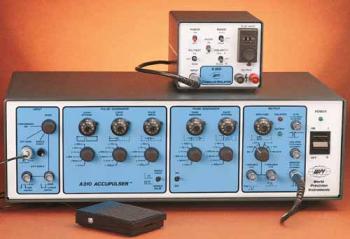Accupulser A310 - Single Channel Pulse Generator
Pulse generator/stimulator with digital or manual control. Generation of single pulses and series. Voltage setting accuracy of about 1%.
- Overview
- Specifications
- Links
Digital electronics' precision and analog controls' practicality
Single channel pulse generator with train capability
TTL and variable voltage output
Benefits
- Various pulse types include train/burst, single-shot, and continuous run
- Monitor, isolator, sync, and variable outputs are among the possible outputs
Applications
- Electrophysiology
The A310 pulse generator/stimulator integrates analog circuitry's fine resolution and continuous adjustment capabilities with the repeatability and accuracy of digital electronics. High resolution, ten-turn potentiometers, and six-position range switches are used to enter all timing parameters. Timing is precise to 1% of the desired value.
Variety of Pulses
Continuous run, single-shot, and train/burst modes can all be used to make pulses. Either of the two external gating inputs or the onboard envelope generator can be used to control how long the train or burst lasts. Constant current pulses and trains can be easily produced when used in conjunction with the A360, A365, A385 or A395. Hands-free manual triggering is made possible using a foot switch.
Multiple Outputs Available
The front panel has five distinct standard BNC outputs. Any TTL triggered stimulus isolator, including WPI's A360, A365, or A385 and others, receives complete pulse width control signals from the isolator output. The monitor output transmits synchronized, full pulse width signals to recording or monitoring equipment like an oscilloscope or data collecting system. An additional synchronized 5 µs TTL pulse is provided by the sync output for external instrumentation triggering. For applications that demand a specific output voltage other than TTL, a variable voltage output delivers two independent full pulse width signals in both positive and negative polarities in two ranges.
Three separate outputs
On the front panel, there are three distinct outputs accessible.
- A monitor's output can be viewed on an oscilloscope or used to trigger other devices with 10-15 V signals (up to 50 mA).
- Any WPI A300 Series stimulus isolator (A365 or A385) can be driven using the pulse stimulator's signal that is simultaneously available at the isolator output. It is also TTL and CMOS compatible.
- With a resolution of 1 mV, variable output may provide signals with a range of ±10 V. Positive and negative signals are given separate variable outputs.
NOTE: Not intended for human use.
You can also visit site of the manufacturer.


